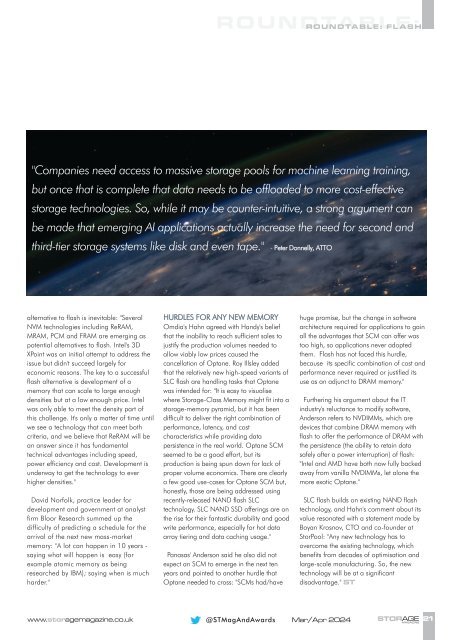ST2403
Create successful ePaper yourself
Turn your PDF publications into a flip-book with our unique Google optimized e-Paper software.
ROUNDTABLE: FLASH<br />
"Companies need access to massive storage pools for machine learning training,<br />
but once that is complete that data needs to be offloaded to more cost-effective<br />
storage technologies. So, while it may be counter-intuitive, a strong argument can<br />
be made that emerging AI applications actually increase the need for second and<br />
third-tier storage systems like disk and even tape." - Peter Donnelly, ATTO<br />
alternative to flash is inevitable: "Several<br />
NVM technologies including ReRAM,<br />
MRAM, PCM and FRAM are emerging as<br />
potential alternatives to flash. Intel's 3D<br />
XPoint was an initial attempt to address the<br />
issue but didn't succeed largely for<br />
economic reasons. The key to a successful<br />
flash alternative is development of a<br />
memory that can scale to large enough<br />
densities but at a low enough price. Intel<br />
was only able to meet the density part of<br />
this challenge. It's only a matter of time until<br />
we see a technology that can meet both<br />
criteria, and we believe that ReRAM will be<br />
an answer since it has fundamental<br />
technical advantages including speed,<br />
power efficiency and cost. Development is<br />
underway to get the technology to ever<br />
higher densities."<br />
David Norfolk, practice leader for<br />
development and government at analyst<br />
firm Bloor Research summed up the<br />
difficulty of predicting a schedule for the<br />
arrival of the next new mass-market<br />
memory: "A lot can happen in 10 years -<br />
saying what will happen is easy (for<br />
example atomic memory as being<br />
researched by IBM); saying when is much<br />
harder."<br />
HURDLES FOR ANY NEW MEMORY<br />
Omdia's Hahn agreed with Handy's belief<br />
that the inability to reach sufficient sales to<br />
justify the production volumes needed to<br />
allow viably low prices caused the<br />
cancellation of Optane. Roy Illsley added<br />
that the relatively new high-speed variants of<br />
SLC flash are handling tasks that Optane<br />
was intended for: "It is easy to visualise<br />
where Storage-Class Memory might fit into a<br />
storage-memory pyramid, but it has been<br />
difficult to deliver the right combination of<br />
performance, latency, and cost<br />
characteristics while providing data<br />
persistence in the real world. Optane SCM<br />
seemed to be a good effort, but its<br />
production is being spun down for lack of<br />
proper volume economics. There are clearly<br />
a few good use-cases for Optane SCM but,<br />
honestly, those are being addressed using<br />
recently-released NAND flash SLC<br />
technology. SLC NAND SSD offerings are on<br />
the rise for their fantastic durability and good<br />
write performance, especially for hot data<br />
array tiering and data caching usage."<br />
Panasas' Anderson said he also did not<br />
expect an SCM to emerge in the next ten<br />
years and pointed to another hurdle that<br />
Optane needed to cross: "SCMs had/have<br />
huge promise, but the change in software<br />
architecture required for applications to gain<br />
all the advantages that SCM can offer was<br />
too high, so applications never adopted<br />
them. Flash has not faced this hurdle,<br />
because its specific combination of cost and<br />
performance never required or justified its<br />
use as an adjunct to DRAM memory."<br />
Furthering his argument about the IT<br />
industry's reluctance to modify software,<br />
Anderson refers to NVDIMMs, which are<br />
devices that combine DRAM memory with<br />
flash to offer the performance of DRAM with<br />
the persistence (the ability to retain data<br />
safely after a power interruption) of flash:<br />
"Intel and AMD have both now fully backed<br />
away from vanilla NVDIMMs, let alone the<br />
more exotic Optane."<br />
SLC flash builds on existing NAND flash<br />
technology, and Hahn's comment about its<br />
value resonated with a statement made by<br />
Boyan Krosnov, CTO and co-founder at<br />
StorPool: "Any new technology has to<br />
overcome the existing technology, which<br />
benefits from decades of optimisation and<br />
large-scale manufacturing. So, the new<br />
technology will be at a significant<br />
disadvantage." ST<br />
www.storagemagazine.co.uk<br />
@STMagAndAwards Mar/Apr 2024<br />
STORAGE<br />
MAGAZINE<br />
21
















